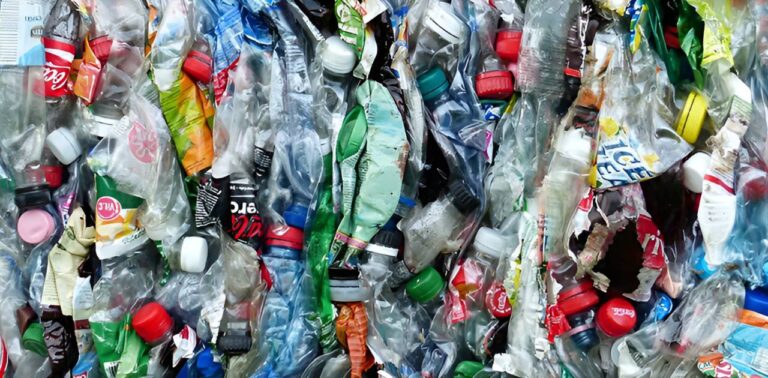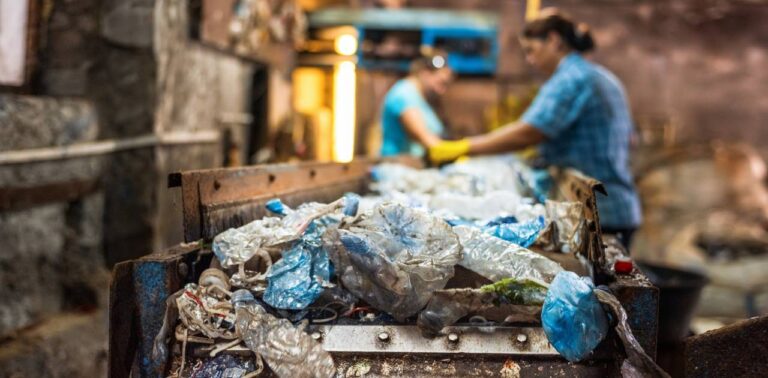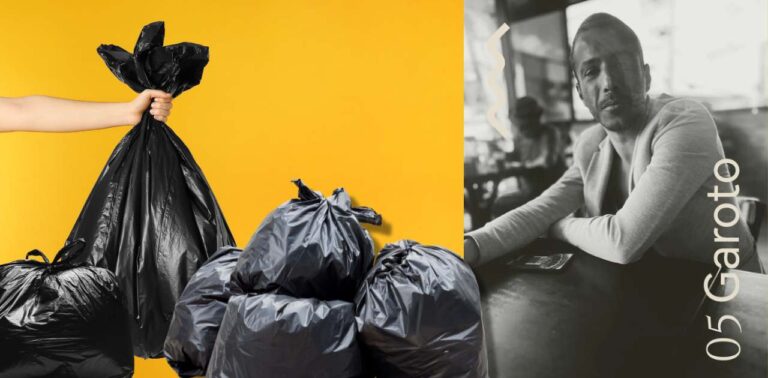Advertisements
The environmental impact caused by improper disposal of PET bottles has been a growing concern in recent years. Fortunately, PET recycling offers an effective solution to reduce this impact by transforming waste into valuable materials such as PET fabric.
The textile industry has benefited greatly from this process, using PET fabric in a wide range of products. In this post, we will explore in detail the industrial process that transforms PET into fabric, its advantages for the environment and the multiple applications of this sustainable innovation.

The Role of PET in the Recycling Industry
PET (polyethylene terephthalate) is widely recognized as the best and most resistant type of plastic for the manufacture of bottles and packaging. Its extensive use in the beverage industry has created a significant challenge: how to deal with the growing volume of discarded packaging that pollutes our planet? The answer to this challenge has been PET recycling, which not only contributes to the preservation of the environment, but also allows the reuse of this material in new products, such as PET fabric.
Recycling PET for fabric production is one of the most common uses for this material. The transformation of PET bottles into polyester fibers, which are then used in the textile industry, exemplifies how recycling can close the life cycle of plastic, converting waste into useful and valuable resources.
The Process of Recycling PET into Fabric
The transformation of PET into fabric involves a series of industrial steps that guarantee the quality and functionality of the final product. Below, we detail this process, from the collection of bottles to the production of polyester fibers.
1. Collection and Preparation: The process begins with the collection of discarded PET bottles, which are collected by waste pickers and sent in bales to recycling facilities. Once at the factory, the bottles undergo a rigorous sorting process to remove impurities and non-recyclable materials.
2. Washing, Grinding and Drying: The selected bottles are washed to remove any beverage residue or labels. They are then ground into small pieces, known as “flakes.” After grinding, the flakes undergo a drying process to eliminate any residual moisture, preparing them for the subsequent steps.
3. Merging and Filtering: The dried flakes are then melted at a temperature of approximately 300ºC. During this melting, the material is filtered to remove any solid residues, such as stones and metals, ensuring that the melted PET is pure and free from contamination.
4. Granulation and Extrusion: After melting and filtering, the PET is cooled with water and transformed into small granules, or chips. These chips are mixed and subjected to an extrusion process at 300ºC, where they are transformed into a viscous paste. This paste is then pumped through microholes that determine the thickness of the resulting fibers.
5. Stretching and Heatsetting: The newly formed fibers undergo a drawing process, which lengthens and strengthens them. They then undergo a heat-setting process, where they are thermally fixed to maintain their shape and strength. After heat-setting, the fibers are still wet and need to be dried before moving on to the next step.
6. Drying and Carding: The dried fibers undergo a carding process, where they are organized and aligned to form a homogeneous, high-quality fabric. Finally, the fibers are packed into bales, ready to be used in various applications, such as textile yarns, pillow fillings, and carpets.
Environmental Advantages of PET Fabric
The use of PET fabric offers numerous environmental advantages, especially in the context of recycling and the circular economy. By recycling PET bottles to produce fabric, the textile industry helps to reduce the volume of plastic waste that would otherwise end up in landfills or, even worse, in the oceans. In addition, the production of PET fabric consumes less energy and natural resources compared to the production of textile fibers from virgin raw materials.
Another significant benefit is the reduction in the carbon footprint associated with the production of synthetic fibers. Because recycled PET has already passed its initial life cycle as packaging, the recycling process requires less energy than producing new plastic, thus contributing to climate change mitigation.
Applications of PET Fabric in Textile Industry
PET fabric has proven to be extremely versatile, being used in a wide variety of textile products. In the apparel industry, PET fabric is often used to produce clothing, accessories, and footwear. Its durability and strength, combined with the material’s lightweight nature, make it a popular choice for products that need to withstand daily wear and tear.
Additionally, PET fabric is widely used in both industrial and domestic applications. It can be found in pillow stuffing, rugs, carpets, and even automotive products. Its water resistance and ability to maintain its shape make PET fabric an ideal choice for these applications where durability is essential.
The Economic Impact of PET Recycling
Recycling PET for fabric production also has a positive economic impact. The growing demand for sustainable products has led to an increase in PET fabric production, creating jobs and stimulating the circular economy. Companies that invest in PET fabric recycling and production technologies are at the forefront of innovation, promoting sustainable business practices that benefit both the environment and the economy.
Additionally, using PET fabric can reduce production costs in some industries, as recycled material can be cheaper than virgin raw materials. This allows companies to offer sustainable products at competitive prices, encouraging consumers to make more environmentally friendly choices.
The Future of PET Fabric and Recycling
As awareness of the importance of recycling and sustainability continues to grow, PET fabric is poised to play an even more significant role in the textile industry. Continued innovations in the recycling process and production of recycled polyester fibers promise to further improve the quality and efficiency of PET fabric, making it a viable and preferred alternative for a wide range of applications.
The growing demand for sustainable fashion and eco-friendly products will also drive the use of PET fabric, encouraging brands and consumers to adopt more responsible practices. With increased investment in recycling technologies and the expansion of waste collection infrastructure, PET fabric is likely to become an indispensable part of the sustainable future we all want.
Final Considerations on PET Fabric
PET fabric is a testament to the transformative power of recycling. By converting plastic waste into high-quality textile fibers, it not only helps mitigate the environmental impact of plastic waste, but also promotes innovation and sustainability in the textile industry. With its numerous advantages and applications, PET fabric is shaping the future of fashion and design, offering an eco-friendly alternative that is both practical and responsible.
Check out other interesting facts about recycling clicking here.
Learn how to make art by recycling, Click here.
Summary




I loved the report, are these fabrics sold in stores or only ready-made clothes?
The demand for “PET mesh” is so great that it is difficult to have fabric available for sale. It is common for companies that sell eco-friendly clothing to buy all the fabric on the market. But you can search for the fabric in our search area: http://setorreciclagem.com.br/reciclagem-maquinas-equipamentos
Goodnight,
I would like more information regarding the fibers they contain, something for filling pillows.
Bruno, recycled polyester fibers for stuffing pillows are a common use for PET bottles. It is basically a coarser, or less refined, fiber. Search our search area to find suppliers of the material:
http://setorreciclagem.com.br/reciclagem-maquinas-equipamentos
I would like to know the source of the images of the recycling process….
Fabrício, these images are very old (they are in low resolution, by the way) and I don't have the source reference. I'm looking for new and good images to publish. I count on your understanding...
I would like to know the contact details of suppliers of machines for producing polyester fiber.
I would like to know the contact details of suppliers of machines to produce polyester fibers from recycled PET flakes.
Lincoln, search our search area to find what you are looking for:
http://setorreciclagem.com.br/reciclagem-maquinas-equipamentos
Once PET has been transformed into fabric, is it possible to recycle it? I mean, could these fabrics be transformed into fabrics again in the future?
Another question is whether the water used for this transformation is drinkable? If so, is it possible to use another type of water, for example reused water or another type of water? Thank you.
If it is pure polyester, yes. But in most cases, it is mixed with cotton. So the possibilities become more limited, such as reusing the fabric for stuffing. Regarding water, as its cost becomes more and more expensive, more solutions will emerge, such as reusing and reusing water.
Good morning, I am doing market research in this very promising sector. I am setting up a high-quality super-washed pet grinding plant. Could you provide me with some purchasing contact?
Luciano, do a search in our search area to find the contacts:
http://setorreciclagem.com.br/reciclagem-maquinas-equipamentos
Goodnight.
I'm planning to open a company that turns PET bottles into yarn. Can you tell me where I can sell these yarns?
Thanks.
I would like to know if you have string made from plastic bottles for crocheting
I work with crafts and I want to use fabrics and strings from PET bottles.
Could you tell me about the associations of manufacturers and suppliers?
Att,
I would like to know if any type of waste or pollutant is generated during PET bottle recycling?
Where can I buy recycled fabric ready to make…
Cintia, do a search in our search area to find PET fabric or recycled fabric:
http://setorreciclagem.com.br/reciclagem-maquinas-equipamentos
Dear, where could I buy pet string to insert into my craft work replacing cotton.
Could you help us ?
Regarding the production process, how much does it cost to manufacture a t-shirt? Is there a significant difference in the price of a conventional product (regular t-shirts that we buy) compared to the price of a t-shirt made from PET?
grateful.
Reginald, look for this information in http://www.abipet.org.br, which will certainly have sector data.
Hello, Ricardo
You said in one of your answers that it was possible to reuse PET fabric, if it was pure. But since most of it is not, being mixed with cotton, it ends up becoming stuffing. But what if the mixture was polyester plus elastane? Would there be a problem in the reuse process? I ask this because I am doing a project within the beachwear... a more sustainable brand?
Soraia, the subject is complex and I'm taking the risk of writing here so as not to leave you without an answer. But the answer should come from an expert in the field, okay?
Elastane is a synthetic fiber made up of at least 85% of polyurethane. Polyurethane is a type of polymer and PET – Polyethylene Terephthalate – is another type of polymer. In principle, different plastics are not compatible for recycling. In other words, it is practically impossible to separate the polymers when they are intertwined in a mesh.
I understand that the industry has not yet taken seriously what happens when fabrics are discarded. A useful end for fabrics would be to disintegrate them for use in stuffing, but you can take a look at this article here to see how creativity can be a great ally for the environment: http://setorreciclagem.com.br/reciclagem-de-tecido/reciclagem-de-tecido-madeira-textil
See also the classification of plastic types here: http://setorreciclagem.com.br/reciclagem-de-plastico/identificando-os-plasticos
I hope I helped 😛
I would like to know who are the manufacturers of PET fiber boards, not sheets but rigid boards up to 5mm thick. Can you tell me a source of information?
Bianca, I always recommend going to our search area because it is geolocated, so you can find the supplier near you, ok?
Type “recycled PET sheet” in: http://setorreciclagem.com.br/reciclagem-maquinas-equipamentos
Goodnight!!
I'm citing this post in my college paper and I can't see the publication date.
Could you please provide me with this information?
Grateful!
Hello Rayra. Due to technical issues with the website, the dates are not visible to the public, but it was published on July 9, 2015.